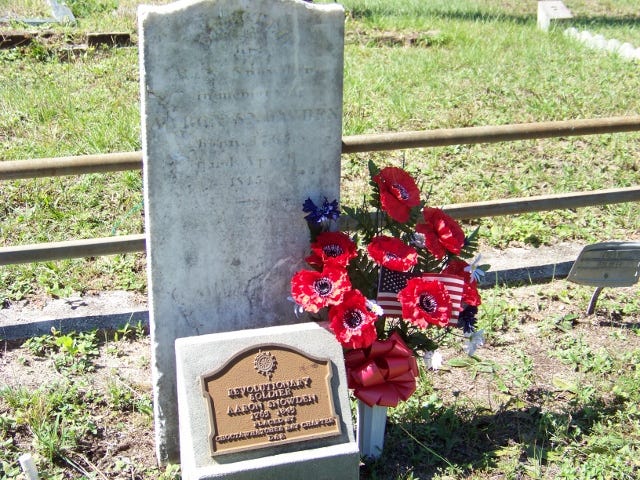
With the Fourth of July holiday just around the corner, the Press Gazette looks at some of Santa Rosa County’s connections to the American Revolution, the nation’s fight for freedom from British control, 1775 to 1783. With help from Rosa Seymour, honorary chapter regent for the Three Rivers Chapter of the Daughters of the American Revolution, and Brian Rucker, history professor from Pensacola State College, this article will look at teenaged Continental Army Veteran Aaron Snowden, and a British galleon lost on the Blackwater River.
According to Rucker, only a few families can possibly trace their ancestry in the area back to the British period around 1781. The Simpson and Marshall families, he said, may trace roots back to the British and Spanish periods in the county. Rucker said, “I haven't confirmed Simpson, but maps from the British period show a Simpson house around Floridatown, and then in 1817 you see John Simpson coming down from the Carolinas. He sets up on Woodbine a few miles away. I don't call that a coincidence. There’s got to be some kind of connection.”
Florida did not join its fellow thirteen English colonies in the revolution and remained loyal to England. Loyalists were called Tories. “A lot of people don’t realize in west and east Florida were the fourteenth and fifteenth colonies. They ask why Florida didn’t join the other 13. The others were well established. These two colonies in Florida were two brand new colonies. They were babies…They were dependent on their mother countries. I know a few people in St. Augustine who were sympathetic to the American cause, but by-and-large, it was a political and economic impossibility.”
The only area in Santa Rosa County with any activity related to the war was the shipyard in Bagdad, according to Rucker. More accurately, he described it as a careening ground where they would also do ship repair. The idea, he said, was to remove barnacles from ships by intentionally turning the vessels onto their sides. It was this facility, Rucker said, the H.M.S. Mentor was likely headed when it sank in the Blackwater River, known as the Middle River at the time.
Pensacola State College archeologists have been looking for the Mentor, a British sloop-of-war, which sank around 1781. It happened the same year as the Spanish siege of Pensacola, when Spanish General Bernardo de Galvez, commander of the Spanish forces in North America, captured the city after the two-month Battle of Pensacola.
According to the Florida Department of State, the H.M.S. Mentor was a captured American privateer Who's Afraid, which was placed into the Royal Navy and renamed H.M.S. Mentor. The British burned the ship in 1781 to prevent her capture by invading Spanish forces. Rucker said, “The British scuttled the ship somewhere in Blackwater Bay.”
In May of the same year the Mentor went down, Aaron Snowden volunteered in the Continental Army as a private in Captain Thomas Evan’s Company, according to Seymour, at the age of 14. “Major John Stannard and Lt. Co. Maurice Murphy were in his chain of command attached to Col. Lemuel Benton’s Regiment of General Francis Marion’s Brigade.”
According to his application for a pension, a document dated November 19, 1883, he lived in 1767 on the Roanoke River in Virginia. The document stated, “I was told my age but cannot prove it because the proof was burnt in the house burnt by the Tories.”
Snowden served for thirteen months and was a veteran by the age of 15. Seymour said, “The Revolutionary War Soldier’s life was hard. No pay, no clothes, no provisions, no rum. When and if Aaron was paid, he received $6.67 a month only to discover that the paper money issued by the Continental Congress was only worth 1 cent.”
A significant battle in Snowden’s service, Seymour said, was the Battle of Eutaw Springs, in South Carolina, September 8, 1781. She said the fighting was furious, “where the blood ran ankle-deep in places.” The British won, she said, but were so weak they withdrew to Charleston where the Americans held them through the remainder of the war. According to Seymour, there is no concrete evidence Aaron fought in this battle, but, “we know that his chain of command from General Marion to Captain Evans was at the Battle of Eutaw Springs. It’s not at all hard to believe Aaron was there, also.”
After his discharge in June of 1782, Snowden married Esther Webster in February 1797 in Rockingham County, North Carolina. They moved to Georgia around 1810 and by 1815 had their seventh child. From there, they moved to Conecuh County, Alabama Territory in 1819 and by 1821 were in Escambia County, Florida Territory, present day Santa Rosa County, according to Seymour. She said, “According to Esther’s petition for a widow’s benefit upon Aaron’s service, he died April 1847 in Santa Rosa County, Florida.” His body rests in the Milton Cemetery.
Seymour said members of the Daughters of the American Revolution, a national organization dedicated to historic preservation, education, and patriotism, place a wreath at Snowden’s grave every year, and added the Sons of the American Revolution partnered with the Three Rivers Chapter and erected a flag there. She also said, “We have partnered with the United States of America Vietnam War Commemoration, to assist in the anniversary of the Vietnam War. We are trying to get the names of all local Vietnam veterans.”
The DAR holds meetings the second Saturday of each month, September through May. Seymour said, “We have programs with historic, educational, patriotic, and National Defense themes. Please contact our Regent for the time and place of our meetings.” Interested parties may reach Seymour by calling 447-2019 or through email at rosasey@bellsouth.net.
This article originally appeared on Santa Rosa Press Gazette: Honoring Santa Rosa County’s revolutionary history
